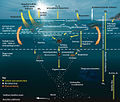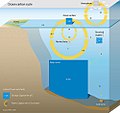 | The CNO cycle (for carbon–nitrogen–oxygen; sometimes called Bethe–Weizsäcker cycle after Hans Albrecht Bethe and Carl Friedrich von Weizsäcker) is one... 36 KB (2,527 words) - 15:01, 17 January 2024 |
 | The Calvin cycle, light-independent reactions, bio synthetic phase, dark reactions, or photosynthetic carbon reduction (PCR) cycle of photosynthesis is... 23 KB (2,704 words) - 23:27, 26 April 2024 |
 | The permafrost carbon cycle or Arctic carbon cycle is a sub-cycle of the larger global carbon cycle. Permafrost is defined as subsurface material that... 58 KB (6,927 words) - 12:51, 28 March 2024 |
 | C4 carbon fixation or the Hatch–Slack pathway is one of three known photosynthetic processes of carbon fixation in plants. It owes the names to the 1960s... 38 KB (4,484 words) - 09:13, 17 April 2024 |
 | Climate change feedbacks (redirect from Climate-carbon feedback) positive feedback is the loss of reflective snow and ice cover. Positive carbon cycle feedbacks occur when organic matter burns or decays, releasing CO2 back... 84 KB (9,153 words) - 21:09, 17 April 2024 |
 | The water cycle (or hydrologic cycle or hydrological cycle), is a biogeochemical cycle that involves the continuous movement of water on, above and below... 38 KB (4,863 words) - 11:23, 25 April 2024 |
 | Biological pump (redirect from Biological carbon pump) biological component. It is the part of the broader oceanic carbon cycle responsible for the cycling of organic matter formed mainly by phytoplankton during... 145 KB (16,299 words) - 20:02, 23 April 2024 |
 | The phosphorus cycle is the biogeochemical cycle that involves the movement of phosphorus through the lithosphere, hydrosphere, and biosphere. Unlike... 41 KB (4,519 words) - 06:50, 22 April 2024 |
table. The carbon cycle is a biogeochemical cycle that is important in maintaining life on Earth over a long time span. The cycle includes carbon sequestration... 25 KB (2,574 words) - 01:11, 24 April 2024 |
 | Photorespiration (also known as the oxidative photosynthetic carbon cycle or C2 cycle) refers to a process in plant metabolism where the enzyme RuBisCO... 27 KB (3,062 words) - 03:48, 9 February 2024 |
 | Greenhouse gas (redirect from Carbon output) change. Carbon dioxide is causing about three-quarters of global warming and can take thousands of years to be fully absorbed by the carbon cycle. Methane... 76 KB (8,044 words) - 06:36, 25 April 2024 |



















